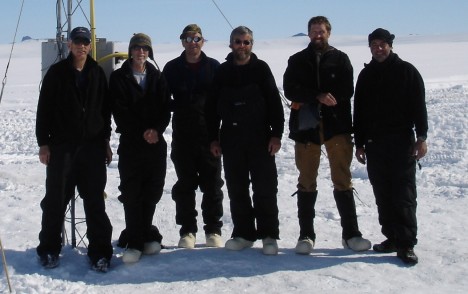

By Ryan Walker
We arrived safely in Christchurch, New Zealand. On Wednesday morning we went over to the International Antarctic Centre to check up on our instruments and equipment. We have five GPS receivers for measuring horizontal ice motion, and two tilt meters for measuring the angle of the ice shelf as it flexes with ocean tides. (We borrowed these instruments from Sridhar Anandakrishnan of Penn State, and will collaborate with him to analyze the data.) Each GPS or tilt meter fits in a plastic case about the size of a carry on suitcase. However, for powering the instruments, we also need solar panels and car batteries (which weigh over 30 pounds each). There are also tools (such as an ice drill — thanks to Bob Hawley of Dartmouth) and over 125 feet of metal pipes that we will use to mount the solar panels and satellite antennas for the GPS. All together, it’s close to 600 pounds of equipment — some shipped from Goddard, and some ordered in New Zealand — so it was a huge relief to see everything in good shape and in the right place.
We found that the batteries had a slightly different type of terminal than we had expected. In order to make a firm connection between the batteries and instruments, which is critical because the stations will be deployed for roughly three months, we had to find specific size bolts and nuts and other wiring components. We spent the rest of the morning visiting a hardware store (twice), an automotive store, and a computer store before successfully finding the parts we needed. Not terribly exciting, but necessary, and handling this sort of issue is a big reason why we arrived in Christchurch a few days before our flight. We did manage to have some fun in the afternoon by visiting the Canterbury Museum, which has historical, cultural, and scientific exhibits and is adjacent to a large and beautiful botanical garden.
Tomorrow afternoon, we’ll be back at the International Antarctic Centre to meet up with the Italian Antarctic program for about an hour’s worth of basic preflight safety training. (Because their stations are nearby, the Korean and Italian programs share flights.) We’ll find out tomorrow exactly what time our flight leaves, but we already know it will be quite early in the morning. It’s a roughly 6 hour flight down to the ice runway at Italy’s Stazione Mario Zucchelli, and we’ll need to wear full Antarctic clothing the whole time. (Fortunately, it’s been fairly cool in Christchurch — highs in the 50’s F — so this shouldn’t be all that uncomfortable.) We haven’t heard yet how we will travel to Jang Bogo Station — it could be by ground vehicles or by helicopter — but we expect this to provide us with our first good photo opportunities before we settle down to work.
By Bob Bindschadler
Christchurch (New Zealand), 29 November — I realized as the moment approached to get in the car and head for the airport that I have been mentally drifting south over the past couple of days. Going over the list of what to pack, then packing, and then mentally running through what I packed, caused me to try to envision every situation I might encounter (at Pine Island, McMurdo Station and even in New Zealand) and what I wanted to be sure to have. “Where’s my ear sweater?” “I need to find my down booties.” Those were the kind of thoughts going through my head. Personal comfort is a big deal in Antarctica—although you can’t take everything with you, when the weather gets nasty you want to have the right stuff.
These same scenes are being played out in other locations; every member of our team is experiencing something very similar as they pack their bags and run through their own list of possible upcoming situations in their minds. Successful Antarctic field work is very much about accurately anticipating what is likely to happen so you are prepared beforehand. When you forget a tool, help is usually very far away and can’t be counted on. You learn to make do with what you have.

Everyone on the team understands this and is preparing accordingly. When our proposal was first submitted, I called them the Dream Team. Some reviewers were offended by the term, but it’s a good way to express the fact that we have the best Antarctic geophysicist, the best engineer of polar oceanographic instrumentation, the best ocean-ice boundary layer oceanographer, the best developer of ice borehole instrumentation and the best lightweight hot water drillers on the planet. Our collective years of polar field experience are measured not in months or years, but decades. I’m extremely proud of the team we have and am confident that if we can’t do this job, this job can’t be done.
Tomorrow, most of us will meet again for the beginning of two months together. We have flown to Christchurch, New Zealand from places scattered across the US: Alaska, California, Pennsylvania, Arizona and Maryland. We come here to receive our cold-weather clothing the National Science Foundation provides us. We try it on for size, change whatever doesn’t fit, return what we don’t want and request special items of personal preference. Each kit will be different in hidden details of shirts, vests, and even underwear, but in the end we all will probably have the same black ski pants/red parka exterior that scientists in the US Antarctic program take on. Good clothing is important—it’s what keeps you warm. You pay attention to what you are given and what you take with you to “The Ice”.